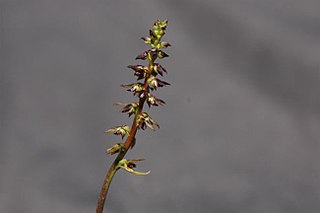
Genoplesium plumosum, commonly known as the Tallong midge-orchid or plumed midge-orchid, is a species of orchid endemic to New South Wales. It is a small orchid only known from a few sites near the towns of Tallong and Wingello on the Southern Tablelands and is only relatively easy to find for about a month, when it flowers. It has been classified as "Endangered" under the EPBC Act.

Genoplesium fimbriatum, commonly known as the fringed midge orchid is a small terrestrial orchid found from southern Queensland to southern New South Wales. It has a single thin leaf and up to thirty green to brownish-green flowers with red stripes and a red-tipped labellum with hairy edges.

Genoplesium nigricans, commonly known as mallee midge orchid, is a species of orchid endemic to Australia. It is a terrestrial herb with a single leaf mostly surrounding the stem, and up to 50 tiny, greenish flowers with a deep maroon-coloured labellum and often have a fruity fragrance. Australian authorities use the name Corunastylis tepperi, a widespread species which has been confused with Corunastylis nigricans, a species with purplish brown flowers and which only occurs on Kangaroo Island and the Eyre Peninsula.
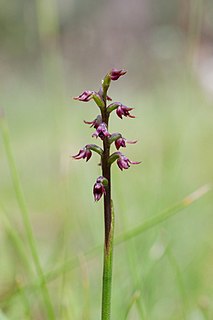
Genoplesium nudum, commonly known as the tiny midge orchid in Australia or the red midge orchid in New Zealand, is a small terrestrial orchid native to south-eastern Australia and New Zealand. It has a single thin leaf fused to the flowering stem and up to forty small, reddish-purple or green and red flowers. Australian and New Zealand authorities use the name Corunastylis nuda but Genoplesium nudum and Prasophyllum transversum are used by the World Checklist of Selected Plant Families.
Genoplesium woollsii, commonly known as the dark midge-orchid, is a species of orchid endemic to New South Wales. It has a single thin, wiry leaf and in autumn has up to thirty five drooping, dark purple flowers on a flowering stem which is fused to the lower part of the leaf.
Genoplesium nudiscapum, commonly known as the bare midge orchid, is a small terrestrial orchid endemic to Tasmania. It has a single thin leaf fused to the flowering stem and up to twenty small, green and reddish-brown flowers. It was thought to be extinct, since it had not been seen since 1852 but was rediscovered in 2008. The species has also been described as occurring on continental Australia. Australian authorities use the name Corunastylis nudiscapa for the Tasmanian endemic but Genoplesium nudiscapum is used by the World Checklist of Selected Plant Families.
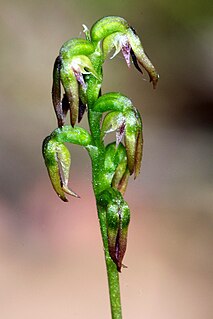
Genoplesium despectans, commonly known as the sharp midge orchid and known as Corunastylis despectans in Australia, is a small terrestrial orchid endemic to south-eastern Australia. It has a single thin leaf fused to the flowering stem and up to forty five small, dark purple or green and purple flowers.

Genoplesium morrisii, commonly known as the bearded midge orchid and known as Corunastylis morrisii in Australia, is a small terrestrial orchid endemic to south-eastern Australia. It has a single thin leaf fused to the flowering stem and up to fifteen small, dark purplish-black or green and purple flowers.
Genoplesium acuminatum, commonly known as the pointed midge orchid and as Corunastylis acuminata in Australia, is a small terrestrial orchid endemic to eastern Australia. It has a single thin leaf fused to the flowering stem and up to sixteen small, hairy, greenish purple to brownish purple flowers. It is found in coastal and near-coastal parts of New South Wales and Queensland.
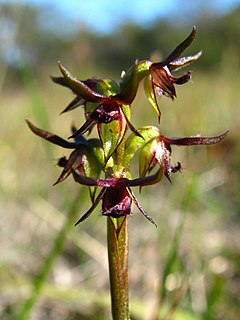
Genoplesium archeri, commonly known as the elfin midge orchid and as Corunastylis archeri in Australia, is a small terrestrial orchid endemic to south-eastern Australia. It has a single thin leaf fused to the flowering stem and up to fifteen small, hairy, yellowish green flowers with purple stripes. It grows in a wide range of habitats in New South Wales, Victoria and Tasmania.

Genoplesium arrectum, commonly known as the erect midge orchid and as Corunastylis arrecta in Australia, is a small terrestrial orchid endemic to south-eastern Australia. It has a single thin leaf fused to the flowering stem and up to twenty small, dark purple flowers. It grows in a montane and subalpine grassland and forest in Victoria and the Australian Capital Territory.
Genoplesium citriodorum, commonly known as the lemon-scented midge orchid and as Corunastylis citriodorum in Australia, is a small terrestrial orchid endemic to New South Wales. It has a single thin leaf fused to the flowering stem and up to thirty three small, lemon scented, dark purplish black flowers. It usually grows under shrubs in shallow sandstone soil in the Blue Mountains.

Corunastylis ciliata, commonly known as the fringed midge orchid, is a small terrestrial orchid endemic to southern Australia. It has a single thin leaf fused to the flowering stem and up to fifteen small, green to greenish yellow flowers with purplish markings and a reddish purple labellum. It was formerly included with Corunastylis archeri, and C. ciliata is regarded as a synonym of Genoplesium archeri by the World Checklist of Selected Plant Families. Plants in this species have fewer, more erect flowers, a less-hairy labellum and have different coloration than C. archeri.

Genoplesium pumilum, commonly known as the green midge orchid in Australia, and the yellow gumland leek orchid in New Zealand is a small terrestrial orchid native to south-eastern Australia and New Zealand. It has a single thin leaf fused to the flowering stem and up to twenty five green to yellowish-green flowers which sometimes have red markings. Australian and New Zealand authorities use the name Corunastylis pumila.
Genoplesium ruppii, commonly known as Rupp's midge orchid and as Corunastylis ruppii in Australia, is a small terrestrial orchid endemic to eastern Australia. It has a single thin leaf fused to the flowering stem and up to twenty five small, hairy green flowers with a purple labellum.
Genoplesium sagittiferum, commonly known as the horned midge orchid and as Corunastylis sagittifera in Australia, is a small terrestrial orchid endemic to New South Wales. It has a single thin leaf fused to the flowering stem and up to ten small, yellowish-green flowers with a hairy reddish labellum.
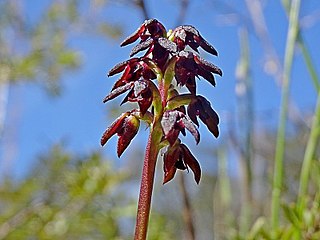
Genoplesium vernale, commonly known as the spring midge orchid or East Lynne midge orchid is a small terrestrial orchid which is endemic to a small area on the south coast of New South Wales. It has a single thin leaf and up to twenty five dark purplish-black flowers with tiny glandular hairs on the sepals and petals.
Genoplesium simulans, commonly known as the Blue Mountains midge orchid is a small terrestrial orchid which is endemic to New South Wales, where it mainly occurs in the Blue Mountains. It has a single thin leaf and up to twenty three dark purplish-black flowers which lean downwards.
Genoplesium superbum, commonly known as the Kangarooby midge orchid, is a small terrestrial orchid which is endemic to New South Wales. It has a single thin leaf and up to thirty two hairy, light reddish flowers which lean downwards and have a dark purple labellum.
Corunastylis laminata, commonly known as the red midge orchid, is a small terrestrial orchid endemic to New South Wales. It has a single thin leaf fused to the flowering stem and up to twenty bright reddish flowers. It grows in heath and grassy forest in a few places on the South Coast and Central Tablelands.










